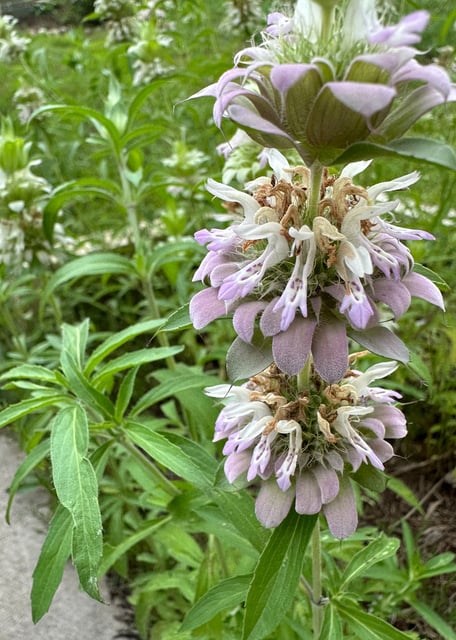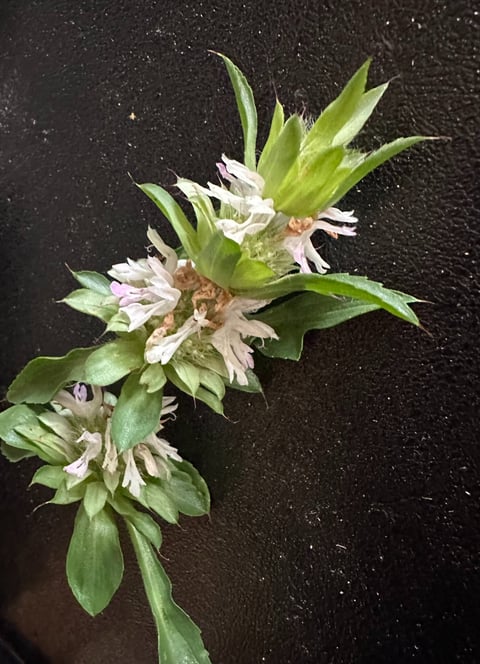Foraging Monarda
Foraging Monarda and how to use it.
FORAGINGPLANTS
Kylie Treekin
6/23/20243 min read
Common Names: Bee Balm, Horsemint, Bergamot, Lemon Beebalm
Scientific Name: Monarda citriodora, monarda fistulosa, Monarda punctata
Family: Lamiaceae, Mint Family
Located: All over the United States, commonly found in open fields or recently disturbed soil and along ditches, also common in a lot of wildflower seed mixes
There are so many varieties of Monarda in the South but there is some variety of it in each state. It's such a beautiful and abundant plant, I have yet to meet one I'm not completely in love with. From the mint family, one of the hallmark identifying features is the square stem, but it's really the triple-stacked flowers that set this plant apart from others. Some flowers have more than 3 blossoms, this is a genetic defect and rare, lucky you if you see one! The butterflies and bees go nuts over this herb too and it was one of the first that I learned on my own herbalism journey.
Monarda is great for the respiratory and digestive systems and has a gently grounding energy, ingested regularity it can help work through and process grief. When eaten raw off the plant, chewing a leaf of monarda will give you a quick free breath mint. Don't eat too much at once though, you might get more peppermint oil than you bargained for.




Check out Merriweather's Guide on Foraging Texas for a wonderfully detailed description of the plant.
Processing Monarda
All above-ground parts of Monarda contain the essential oils which makes it a great candidate for a lot of different uses. Monarda is best harvested when it first starts flowering to capture the most amount of essential oils in the flower. You don't want to harvest it once it's already started drying, though this is a great time to get seed from it. Monarda makes teeny tiny seeds so I like to cut the whole dried flower stalk into a bag since any amount of shaking will loosen the seeds and send them flying.
The first step is almost always the same though, dry the herb, see my guide here for how to dry herbs.
Once you have the dry material, there is almost an unlimited amount you can do with it:
making tea, great on it's own or paired with other herbs
infused honey - Mountain Rose Herbs makes a great guide
making tincture, can be alcohol, glycerine, or vinegar-based
grinding it into flakes as an oregano substitute
using it to add as an ingredient to syrups, I love adding it to my elderberry syrup
great additive to cough drop recipes
WARNING: Please read our Ethical Forager Guide before you attempt to forage any plant. Never ingest a plant unless you are 100% certain it is what you think it is, always get a 2nd opinion if you aren't sure or it's your first time with this plant.
Happy Foraging!
Feel free to DM or tag us on IG if you would like a positive identification on this plant @treekintrove
DISCLAIMER: THIS WEBSITE DOES NOT PROVIDE MEDICAL ADVICE
The information, including but not limited to, text, graphics, images, and other material contained on this website are for informational purposes only. No material on this site is intended to be a substitute for professional medical advice, diagnosis or treatment. Always seek the advice of your physician or other qualified health care provider with any questions you may have regarding a medical condition or treatment and before undertaking a new health care regimen, and never disregard professional medical advice or delay in seeking it because of something you have read on this website.
Perform an allergy test!
Aside from having an allergy test done at the doctor's office, you can also perform an allergy test on yourself if you are not sure if you will be sensitive to a new herb or foragable that you might ingest. Feel our guide here on how to perform an allergy test. Be responsible with your health!
